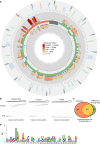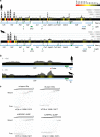LRPPRC-mediated folding of the mitochondrial transcriptome
- PMID: 29146908
- PMCID: PMC5691074
- DOI: 10.1038/s41467-017-01221-z
LRPPRC-mediated folding of the mitochondrial transcriptome
Abstract
The expression of the compact mammalian mitochondrial genome requires transcription, RNA processing, translation and RNA decay, much like the more complex chromosomal systems, and here we use it as a model system to understand the fundamental aspects of gene expression. Here we combine RNase footprinting with PAR-CLIP at unprecedented depth to reveal the importance of RNA-protein interactions in dictating RNA folding within the mitochondrial transcriptome. We show that LRPPRC, in complex with its protein partner SLIRP, binds throughout the mitochondrial transcriptome, with a preference for mRNAs, and its loss affects the entire secondary structure and stability of the transcriptome. We demonstrate that the LRPPRC-SLIRP complex is a global RNA chaperone that stabilizes RNA structures to expose the required sites for translation, stabilization, and polyadenylation. Our findings reveal a general mechanism where extensive RNA-protein interactions ensure that RNA is accessible for its biological functions.
Conflict of interest statement
The authors declare no competing financial interests.
Figures




Similar articles
-
SLIRP Regulates the Rate of Mitochondrial Protein Synthesis and Protects LRPPRC from Degradation.PLoS Genet. 2015 Aug 6;11(8):e1005423. doi: 10.1371/journal.pgen.1005423. eCollection 2015 Aug. PLoS Genet. 2015. PMID: 26247782 Free PMC article.
-
LRPPRC is necessary for polyadenylation and coordination of translation of mitochondrial mRNAs.EMBO J. 2012 Jan 18;31(2):443-56. doi: 10.1038/emboj.2011.392. Epub 2011 Nov 1. EMBO J. 2012. PMID: 22045337 Free PMC article.
-
LRPPRC/SLIRP suppresses PNPase-mediated mRNA decay and promotes polyadenylation in human mitochondria.Nucleic Acids Res. 2012 Sep;40(16):8033-47. doi: 10.1093/nar/gks506. Epub 2012 May 31. Nucleic Acids Res. 2012. PMID: 22661577 Free PMC article.
-
Position-dependent interactions of Y-box protein 2 (YBX2) with mRNA enable mRNA storage in round spermatids by repressing mRNA translation and blocking translation-dependent mRNA decay.Mol Reprod Dev. 2016 Mar;83(3):190-207. doi: 10.1002/mrd.22616. Epub 2016 Mar 7. Mol Reprod Dev. 2016. PMID: 26773323 Review.
-
RNA-binding proteins in tumor progression.J Hematol Oncol. 2020 Jul 11;13(1):90. doi: 10.1186/s13045-020-00927-w. J Hematol Oncol. 2020. PMID: 32653017 Free PMC article. Review.
Cited by
-
LRPPRC and SLIRP synergize to maintain sufficient and orderly mammalian mitochondrial translation.Nucleic Acids Res. 2024 Oct 14;52(18):11266-11282. doi: 10.1093/nar/gkae662. Nucleic Acids Res. 2024. PMID: 39087558 Free PMC article.
-
Translation initiation of leaderless and polycistronic transcripts in mammalian mitochondria.Nucleic Acids Res. 2023 Jan 25;51(2):891-907. doi: 10.1093/nar/gkac1233. Nucleic Acids Res. 2023. PMID: 36629253 Free PMC article.
-
The longevity effects of reduced IGF-1 signaling depend on the stability of the mitochondrial genome.bioRxiv [Preprint]. 2025 Jun 6:2025.06.03.656903. doi: 10.1101/2025.06.03.656903. bioRxiv. 2025. PMID: 40501628 Free PMC article. Preprint.
-
Genetic insights into the complexity of premature ovarian insufficiency.Reprod Biol Endocrinol. 2024 Aug 2;22(1):94. doi: 10.1186/s12958-024-01254-2. Reprod Biol Endocrinol. 2024. PMID: 39095891 Free PMC article. Review.
-
SLIRP Interacts with Helicases to Facilitate 2'-O-Methylation of rRNA and to Promote Translation.J Am Chem Soc. 2019 Jul 17;141(28):10958-10961. doi: 10.1021/jacs.9b04424. Epub 2019 Jul 3. J Am Chem Soc. 2019. PMID: 31260285 Free PMC article.
References
Publication types
MeSH terms
Substances
LinkOut - more resources
Full Text Sources
Other Literature Sources
Molecular Biology Databases

